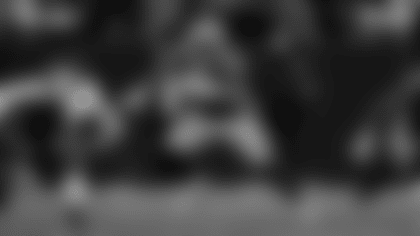With this year's NFL Draft spread out over three days for the first time, an intriguing question is whether the additional overnight down time will lead to more swapping of picks and jockeying for position at the start of each new day.
During his annual pre-draft press conference on Friday, Packers General Manager Ted Thompson said that's certainly possible. But he's not convinced the second and fourth rounds, which following Thursday night's first round will be the "opening rounds" on Friday and Saturday, respectively, are going to become the trading frenzy that some are predicting.
"There will be conversations," Thompson said. "Whether there will be more trades or not I don't know.
"I don't know how much (trading there) will be after the first round."
Thompson's skepticism stems from the fact that he doesn't often see many surprise picks in the first round. A large number of surprises Thursday night could leave a handful of talented players many teams have graded as first-rounders available early on Friday, leading to teams trying to jockey their way up the board so as not to miss out.
But if the first round goes for the most part as predicted, there may not be the demand to get to the top of the second round.
The fourth round, though, probably will generate that interest, as it usually does. With the fourth round opening the second day of the traditional two-day draft in recent years, teams have used the overnight to re-set their draft boards and see if there's a highly rated player who's worth moving up to get. That activity probably will continue this year, except that the fourth round is on the third day and not the second.
Last year, for example, the New York Jets had their eye on Iowa running back Shonn Greene and traded for the top pick in the fourth round to make sure they got him.
Former Packers GM Ron Wolf always saw a lot of value in picking near the top of the fourth round when the board re-sets, and Thompson shares that view. Whether there will be a player worth moving up for is impossible to predict, though.
"I think it's always good to be early when you get to start up again, because you've had a chance to kind of see what happened and not only see where you are but see where other teams are in terms of maybe addressing some of their needs," Thompson said. "It's a guessing game, though."
Thompson may have his GM brethren guessing as to how he's going to approach things this year after his surprise move a year ago. Having traded up only once in the first nine drafts he ran (five with Seattle, four in Green Bay) while trading down numerous times, Thompson boldly traded up in 2009 to give the Packers an additional first-round pick, selecting linebacker Clay Matthews at No. 26 overall.
The move paid off, as Matthews made the Pro Bowl as a rookie and looks like he could be a pass-rushing star at outside linebacker for years to come.
"We'll do anything," Thompson said. "We've said it before we traded up and we said it even since then. If we think something is of value and it helps our team, we'll try to do that."
Many draft analysts expect the Packers to try to focus on three positions in this draft - offensive tackle, cornerback and outside linebacker, in whatever order.
The reasons for each make sense.
--Veteran tackles Chad Clifton and Mark Tauscher have been re-signed, but the team needs long-term prospects at the position, particularly Clifton's spot on the left side, because second-year pro T.J. Lang is probably more suited to right tackle, if not a guard spot.
--The secondary had trouble against high-powered passing offenses down the stretch last year when the cornerback depth was tested, and Pat Lee, Will Blackmon and veteran Pro Bowler Al Harris all will be coming off knee injuries in 2010. Their availability for the start of training camp remains in question, too.
--A counterpart to Matthews on the opposite side of the defense could help expand the 3-4's capabilities, and with the free-agent departure of Aaron Kampman, only second-year pro Brad Jones played the spot extensively in 2009.
But Thompson wasn't revealing on Friday anything that could be construed as priorities for this draft, even with regards to a long-term plan at left tackle. While acknowledging that need factors into the decision-making when the talent level of potential draftees is relatively equal, he hasn't strayed from taking the best player available at any given spot, and that won't change now.
"There are a lot of positions where you'd say we'd like to do this or like to do that," Thompson said.
"I honestly and truly believe that if you get caught up trying to reach for need at all, that's when you make your mistakes. And I feel like our core team is strong enough that we don't have to search out like that. I know it's what I always say, but I really mean it."
{sportsad300}Another item of importance for Thompson in the draft is the character of players. He's committed to having as cohesive and strong a locker room as he can assemble, and he acknowledged that some potential draftees are such character risks that they are taken off Green Bay's board entirely, with no consideration given to selecting them.
"We do a lot of work there," Thompson said of the character issue. "But you're still dealing with young men that are still learning their way in life, so there's always some question marks about how things are going to go.
"Or there's also question marks about how things have gone. Did someone make a mistake as a teenager or young man in college that is really out of character and shouldn't really be a factor going forward, or is it something else? We spend an extraordinary amount of time working on that, and it's not an easy call."
Neither is predicting just how this new three-day format is going to go, particularly for longtime personnel people like Thompson who have operated under the two-day format their entire front-office careers.
But change can produce some interesting results, too. Matthews is proof of that.
"We've always done it differently, so change is not a comfortable thing for people like me in my business," Thompson said. "But I'm pretty sure it's going to work out. I'm pretty sure everybody is going to pick and do all that. It's just different, so there's always a certain amount of anxiety I think."














